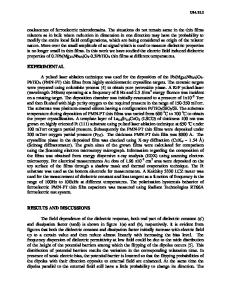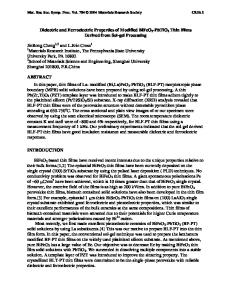Ferroelectric and Piezoelectric Properties of MOCVD Pb(Mg 1/3 Nb 2/3 )O 3 -PbTiO 3 Epitaxial Thin Films
- PDF / 887,891 Bytes
- 6 Pages / 417.6 x 639 pts Page_size
- 29 Downloads / 351 Views
517 Mat. R.s. Soc. Symp. Proc. Vol. 596 ©2000 Materials Research Society
EXPERIMANTAL DETAILS The PMN and PMN-PT thin films were deposited in a horizontal, cold wall MOCVD reactor. Tetraethyl lead, Pb(C2H5)4, niobium pentaethoxide, Nb(OC2 H5 )5, solid magnesium 03-diketonate, Mg(C1 1 H1 90 2)2, and titanium isopropoxide, Ti(C 3H 70) 4, were chosen as the metal ion precursors. Single crystal (001) SrTiO 3 substrates were used to optimize the growth and to study the microstructure of the films. For electrical characterization, PMN-PT films were deposited on (001) scudocubi, SrRuO3 films deposited by off-axis sputtering on (001) SrTiO 3 substrates [14]. Pt top electrodes were evaporated through a shadow mask onto the samples at 350'C, so as to form capacitor structures. Further details of the deposition process are reported elsewhere [15]. Table I summarizes the general range of deposition conditions over which films with reasonable quality were obtained. Because of the large number of adjustable parameters and, in particular, variations of the solid Mg precursor vapor pressure, different samples were deposited under rather different absolute conditions in order to achieve phase purity. This is reflected in the broad ranges quoted for some parameters. Table I: Deposition conditions for PMN-PT films Substrate Temperature: Reactor Pressure:
700-780 0 C 6 Torr
Precursor Temperatures:
Pb: Mg: Nb: Ti:
28-30 0 C 120-140'C 78-85'C 30-36'C
Pressure in Precursor Chamber:
Pb: Mg: Nb: Ti:
500-800 Torr 18 Torr 18 Toff 100-200 Torr
Carrier Gas Flow Rate (N2):
Pb: Mg: Nb: Ti:
20-36 36-42 55-62 14-26
Oxygen Flow Rate: Background Gas Flow Rate (N2):: Deposition Rate:
400 SCCM 200 SCCM 4-6nm/min.
SCCM SCCM SCCM SCCM
Film Ti content x was estimated based on the relative precursor parameters and deposition rates for the PMN and PT end members. Ti content was also estimated by measurement of film refractive index, which has been demonstrated to be a simple linear function of the refractive indices of the end members for other perovskite solid solutions [16]. X-ray diffraction (XRD) and transmission electron microscopy were used for structural characterization of the PMN and PMN-PT thin films; TEM results will be discussed elsewhere [17]. Room temperature electrical characterization to determine permnittivity and loss tangent as a function of electric field were performed at 10 kHz and
518
0. 1Vrms oscillation level using an HP4192A impedance analyzer. Hysteresis loops were measured on a Radiant RT6000 test system. A Digital Instruments D13000 scanning probe microscope (SPM) was employed to analyze the surface morphology and roughness of the films. Double beam laser interferometry was used to determine piezoelectric coefficients [181. RESULTS AND DISCUSSION It was found that XRD 0-20 scans of optimized PMN-PT/SrTiO 3 films exhibited only (001) peaks of the SrTiO 3 substrate and the pseudocubic PMN-PT, as shown in Figure 1 a) and b) for films with thicknesses of approximately 300nm. Samples deposited on SrRuO 3/SrTiO 3 we
Data Loading...











